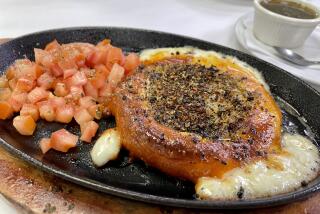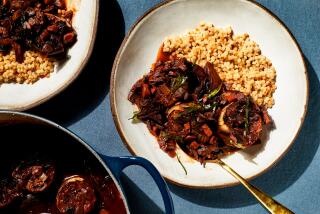dining swiss-style Raclette: : The aroma of melted cheese is the attraction of this filling, hearty meal appropriate for parties large or small on chilling winter nights
- Share via
On cold winter nights as a child I used to read and reread “Heidi” by Johanna Spyri. Endowed with a healthy imagination, I would envision myself seated on a sturdy but crudely made stool side by side with Heidi as Grandfather toasted a hunk of cheese over a roaring fire in his mountain hut’s fireplace. I could actually smell the strong, rich aroma of the cheese as it softened on the long fork and became runny enough to be spread over a big slice of crusty bread. Oh, how I savored that simple meal. To me, it was an imaginary gastronomic delight that somehow never quite came off when I tried to reconstruct the meal with a chunk of Velveeta and a slice of Wonder Bread in our fireplace at home.
Maybe it was the recollection of Grandfather’s culinary offering that made my introduction to raclette, a more stylized and decidedly modernized version of Grandfather’s simple repast, such a memorable one. Or maybe it was just that the novelty of dining raclette-style appealed to me.
Like a fondue, this Swiss cheese-based meal is fun when shared with family and friends.
The word raclette comes from the French verb recler, meaning “to scrape.” A classical raclette involves placing a cut wheel of meltable Swiss cheese close to the fire and letting it soften to the point where the melted cheese can be scraped onto a plate and served with a small boiled potato, cornichons--those tiny tart French pickles--and small pickled onions. Just the thought of it smacks of ski lodges and ice rinks and other snow- or ice-based pursuits.
But raclette has moved away from the fireplace and onto the dining table today. The cheese can be melted on heat-proof plates placed under the broiler in a home oven, or in any of a number of specially designed raclette machines that melt the cheese quickly and efficiently to the perfect scraping point. Some of these machines hold half or quarter wheels of raclette cheese that are melted by electric heating elements placed close to the cut side of the wheel. Probably the most popular way to enjoy a raclette meal today, however, is to use one of the attractive table-top raclette ovens that are becoming more widely available. These versatile little electrical appliances come equipped with small individual non-stick pans that hold slices of cheese to be melted. Although these technically are not true raclette machines because one doesn’t scrape the melted cheese from the wheel, they nonetheless are called raclettes and make sharing one of these delightful communal meals great fun. Some of the modern raclettes are equipped with grill-tops and removable crepe pans that extend the usage of the unit far beyond its primary purpose of melting cheese for a raclette meal.
To enjoy a genuine Swiss-style raclette dinner, one should use, as might be expected, raclette cheese. This is a Swiss-made, mountain cheese that is hard to find in this area. We found some at the Cheese Store in Beverly Hills, and it may be available in other specialty food shops. While the real thing is undoubtedly the best choice if you want to enjoy an authentic meal of this type, other good, meltable cheeses can be substituted. Gruyere, Appenzeller, natural Swiss-style cheeses . . . even Jack, if you like the flavor, are possibilities. It may be necessary to experiment with several cheeses or a mixture of cheeses to develop just the right soft, but not stringy, well-flavored melted product. Unless you use the true raclette cheese, the choice is a subjective one.
Once you have chosen the cheese or the mixture that pleases you, you can create as simple or elaborate a raclette party as you want. It’s a good idea, however, to try the real thing at least once first. Then expand your ideas and see how creative you can be by adding other ingredients and seasonings to the melted cheese. Be warned, however. A raclette meal is very rich. Even hearty appetites will be assuaged fairly quickly. Two or three small boiled potatoes and five or six slices of cheese per person, plus the pickles and onions for accent, probably will be quite ample, although a few hearty eaters may want more.
To show how variations on a theme can work, The Times came up with a cheese-and-fruit dessert version of raclette that met with great favor on the part of those who tried it. A platter of chilled fresh fruits, cut into bite-size pieces, were served with chunks of crusty French bread and the melted cheese.
For something a little different, try melting thin wedges of Danish Saga Blue cheese, which is a decadently rich mixture of cream and blue cheeses in place of the more traditional ones. Be careful when heating this type of cheese, however, for it will liquefy and separate out very quickly unless you watch it constantly. (If you let it heat too long and it gets messy, just sop it up from the pan with a chunk of bread. The flavor with the bread and fruit is exquisite, well worth the mess.)
Brie is another good cheese to try this way.
One last tip about dining a la raclette. A raclette party is highly informal. Once you have placed your pan filled with cheese and whatever else you have chosen to add under the broiler, be prepared to eat when the cheese is melted. Don’t wait for everyone else or your food will get cold and lose its charm.
TRADITIONAL RACLETTE
2 to 3 small to medium new potatoes per person
Raclette, Appenzeller or other natural Swiss-type, meltable cheese
Cornichons
Pickled onions
Wash new potatoes well and remove thin strip of peel around center. Boil in water to cover until potatoes are tender. Drain and keep hot.
Arrange large wedge of cheese on cutting board. If cheese has hard rind, rind can be trimmed back as cheese is sliced. Place cornichons and onions in separate dishes near cheese board.
At serving time, slice thin strips of cheese from wedge and place in raclette oven pan. (Begin with 2 or 3 strips of cheese, then add or subtract amount used according to taste in ensuing batches.) Slide pan under heating element and heat just long enough for cheese to melt. Remove pan from oven, scrape cheese onto hot serving plate and serve with hot potato and cornichons and onions to taste.
Variations: If desired, other ingredients may be added to cheese pan before cheese is melted, or they may be sprinkled over melted cheese or served separately. The following provide some interesting textures and flavors for an expanded raclette party:
--Sliced pepperoni
--Sliced hard salami
--Canned baby corn
--Chopped green or red onions
--Sliced mushrooms
--Sliced green and red peppers
--Cooked baby shrimp
--Strips of jicama
--Chopped celery
--Crisp cooked, chopped bacon
--Cooked asparagus tips
--Crisp Belgian endive
DESSERT RACLETTE
Raclette, Saga Blue, Brie or other meltable cheese
Sliced melons, apples, oranges, berries or other fruits
Warm, crusty French bread
Arrange cheese or cheeses on cutting board. Arrange fruits attractively on platter or in separate bowls or plates. Place warm, whole loaf of bread on bread board.
To serve, place small strips or wedges of cheese in raclette oven pan and heat until melted. Break off chunk of bread and spread melted cheese over it. Eat bread and cheese with assortment of fruits. Or scrape cheese over fruits and eat with bread as an accompaniment. Serve with chilled fruity white wine.
More to Read
Eat your way across L.A.
Get our weekly Tasting Notes newsletter for reviews, news and more.
You may occasionally receive promotional content from the Los Angeles Times.








